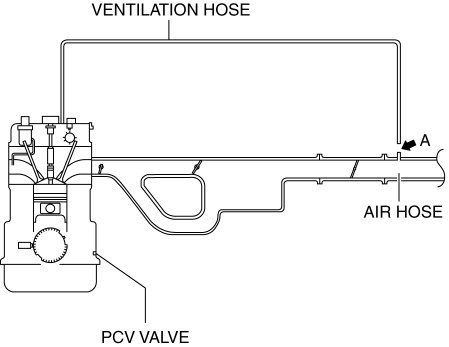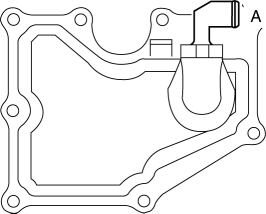Mazda 3 Service Manual: Positive Crankcase Ventilation (PCV) Valve Inspection [Mzr 2.0, Mzr 2.5]
Airflow Inspection
1. Disconnect the section (A) of the ventilation hose shown in the figure.

2. Start the engine and verify that vacuum is applied to the end of the disconnected ventilation hose while the engine is idling.
NOTE:
-
Because it is difficult to directly inspect the PCV valve, determine the integrity of the PCV valve by performing a simple inspection of the ventilation hose airflow condition.If the PCV valve is operating normally, vacuum occurs in the ventilation hose, however, if there is a malfunction in the PCV valve, positive pressure occurs in the ventilation hose because the blow-by gas is circulated to the air hose from the ventilation hose.
-
Verify the ventilation hose vacuum using the following methods:
-
When the tip of your finger touches the end of the ventilation hose, it is suctioned by the hose.
-
When a thin scrap of paper contacts the end of the ventilation hose, it is suctioned by the hose.
3. If it can be verified that vacuum occurs in the ventilation hose, the positive crankcase ventilation (PCV valve) system is determined to be normal.
-
If positive pressure occurs in the ventilation hose, perform the procedure from Step 4 to examine the PCV valve.
4. Remove the battery cover..
5. Disconnect the negative battery cable..
6. Remove the intake manifold and the fuel distributor component as a single unit..
7. Remove the PCV valve and the oil separator as a single unit..
8. Verify that there is no airflow when pressure is applied to port A.

-
If there is airflow, replace the PCV valve..
9. Verify that there is airflow when vacuum is applied to port A.
-
If there is no airflow, replace the PCV valve..
 EGR Valve Removal/Installation [Mzr 2.0, Mzr 2.5]
EGR Valve Removal/Installation [Mzr 2.0, Mzr 2.5]
1. Remove the battery cover..
2. Disconnect the negative battery cable..
3. Drain the engine coolant from the radiator..
4. Remove the air cleaner and the air hose as a single unit..
5. Remove ...
 Positive Crankcase Ventilation (PCV) Valve Removal/Installation [Mzr 2.0, Mzr
2.5]
Positive Crankcase Ventilation (PCV) Valve Removal/Installation [Mzr 2.0, Mzr
2.5]
1. Remove the battery cover..
2. Disconnect the negative battery cable..
3. Remove the intake manifold and the fuel distributor component as a single
unit..
4. Remove in the order indicated in ...
Other materials:
Supplier Identification Procedure [Audio]
Identification Using the Label or Inscribed Lettering
1. Disconnect the negative battery cable..
2. Remove the center panel..
3. Remove the audio unit..
4. Verify the supplier by referring to the label attached to each unit.
Verify Using the Diagnostic Assist Function
Without display
...
Front Door Latch And Lock Actuator Inspection
1. The following actuators and switches are integrated with the front door latch
and lock actuator. Inspect the front door latch and lock actuator according to each
inspection procedure for the following items.
Front door lock actuator.
Door lock-link switch.
Door latch s ...
Starter Cut Relay Inspection [MTX]
Advanced Keyless Entry And Push Button Start System Only
1. Disconnect the negative battery cable.
2. Remove the following parts:
a. Front scuff plate (LH).
b. Front side trim (LH).
c. Side wall.
d. Console.
3. Set the bonnet release lever out of the way..
4. Remove the lower panel.. ...
